A Novel Analytical Model for the IEEE 802.11p/bd Medium Access Control, with Consideration of the Capture Effect in the Internet of Vehicles
Abstract
:1. Introduction
- A novel 2-D Markov chain model is proposed, which is different from the existing ones. In the proposed 2-D Markov chain model, all the key characteristics of the DCF are considered, i.e., backoff freezing mechanism, immediate access mechanism, finite retry limit, post-backoff procedure, different packet arrival probabilities under different channel states for the empty buffer and queuing model of the buffer queue.
- The capture effect under a Nakagami-m fading channel is considered. Then, the closed-form expressions of successful transmission, collided transmission, normalized unsaturated throughput, and average packet delay are all meticulously derived, respectively.
- To verify the accuracy of the proposed model, simulation results are given. In addition, it is also compared with the existing analytical models. As expected, the proposed model is more accurate than the existing models in terms of normalized unsaturated throughput and average packet delay.
2. Related Work
3. The Proposed Analytical Model
3.1. Brief Description of DCF
3.2. A Novel 2-D Markov Chain Model
3.3. Calculation of Normalized Throughput
3.4. Calculation of Average Packet Delay
4. Model Valuation and Performance Evaluation
4.1. Transmission Probability and Collision Probability
4.2. Normalized Throughput
4.3. Average Packet Delay
5. Conclusions
Author Contributions
Funding
Institutional Review Board Statement
Informed Consent Statement
Data Availability Statement
Conflicts of Interest
References
- Ning, H.; An, Y.; Wei, Y.; Wu, N.; Mu, C.; Cheng, H.; Zhu, C. Modeling and analysis of traffic warning message dissemination system in VANETs. Veh. Commun. 2023, 39, 100566. [Google Scholar] [CrossRef]
- Wu, Q.; Zheng, J. Performance modeling and analysis of the ADHOC MAC protocol for vehicular networks. Wirel. Netw. 2016, 22, 799–812. [Google Scholar] [CrossRef]
- Wu, G.; Wang, H.; Zhang, H.; Zhao, Y.; Yu, S.; Shen, S. Computation offloading method using stochastic games for software-defined-network-based multiagent mobile edge computing. IEEE Internet Things J. 2023, 10, 17620–17634. [Google Scholar] [CrossRef]
- Wu, G.; Xu, Z.; Zhang, H.; Shen, S.; Yu, S. Multi-agent DRL for joint completion delay and energy consumption with queuing theory in MEC-based IIoT. J. Parallel Distrib. Comput. 2023, 176, 80–94. [Google Scholar] [CrossRef]
- Zhang, P.; Chen, N.; Shen, S.; Yu, S.; Kumar, N.; Hsu, C.H. AI-enabled space-air-ground integrated networks: Management and optimization. IEEE Netw. 2023; early access. [Google Scholar] [CrossRef]
- Wang, C.; Jiang, C.; Wang, J.; Shen, S.; Guo, S.; Zhang, P. Blockchain-aided network resource orchestration in intelligent internet of things. IEEE Internet Things J. 2022, 10, 6151–6163. [Google Scholar] [CrossRef]
- Wu, G.; Chen, X.; Gao, Z.; Zhang, H.; Yu, S.; Shen, S. Privacy-preserving offloading scheme in multi-access mobile edge computing based on MADR. J. Parallel Distrib. Comput. 2024, 183, 104775. [Google Scholar] [CrossRef]
- Guo, H.; Zhou, X.; Liu, J.; Zhang, Y. Vehicular intelligence in 6G: Networking, communications, and computing. Veh. Commun. 2022, 33, 100399. [Google Scholar] [CrossRef]
- Yang, Y.; Wei, L.; Wu, J.; Long, C.; Li, B. A blockchain-based multidomain authentication scheme for conditional privacy preserving in vehicular ad-hoc network. IEEE Internet Things J. 2022, 9, 8078–8090. [Google Scholar] [CrossRef]
- Wu, Q.; Wang, X.; Fan, Q.; Fan, P.; Zhang, C.; Li, Z. High stable and accurate vehicle selection scheme based on federated edge learning in vehicular networks. China Commun. 2023, 20, 1–17. [Google Scholar] [CrossRef]
- Long, D.; Wu, Q.; Fan, Q.; Fan, P.; Li, Z.; Fan, J. A power allocation scheme for MIMO-NOMA and D2D vehicular edge computing based on decentralized DRL. Sensors 2023, 23, 3449. [Google Scholar] [CrossRef] [PubMed]
- Ji, B.; Zhang, X.; Mumtaz, S.; Han, C.; Li, C.; Wen, H.; Wang, D. Survey on the internet of vehicles: Network architectures and applications. IEEE Commun. Stand. Mag. 2020, 4, 34–41. [Google Scholar] [CrossRef]
- Wu, Q.; Wang, S.; Ge, H.; Fan, P.; Fan, Q.; Letaief, K.B. Delay-sensitive task offloading in vehicular fog computing-assisted platoons. IEEE Trans. Netw. Serv. Man. 2023; early access. [Google Scholar] [CrossRef]
- Wu, Q.; Zhao, Y.; Fan, Q.; Fan, P.; Wang, J.; Zhang, C. Mobility-aware cooperative caching in vehicular edge computing based on asynchronous federated and deep reinforcement learning. IEEE J. Sel. Top. Signal Process. 2023, 17, 66–81. [Google Scholar] [CrossRef]
- Zheng, J.; Wu, Q. Performance modeling and analysis of the IEEE 802.11p EDCA mechanism for VANET. IEEE Trans. Veh. Technol. 2016, 65, 2673–2688. [Google Scholar] [CrossRef]
- Wu, Z.; Bartoletti, S.; Martinez, V.; Todisco, V.; Bazzi, A. Analysis of co-channel coexistence mitigation methods applied to IEEE 802.11p and 5G NR-V2X sidelink. Sensors 2023, 23, 4337. [Google Scholar] [CrossRef] [PubMed]
- Bianchi, G. Performance analysis of the IEEE 802.11 distributed coordination function. IEEE J. Sel. Areas Commun. 2000, 18, 535–547. [Google Scholar] [CrossRef]
- Malone, D.; Duffy, K.; Leith, D. Modeling the 802.11 distributed coordination function in nonsaturated heterogeneous conditions. IEEE/ACM Trans. Netw. 2007, 15, 159–172. [Google Scholar] [CrossRef]
- Madhavi, T.; Rao, G.S.B. Modelling collision alleviating DCF protocol with finite retry limits. Electron. Lett. 2015, 51, 185–187. [Google Scholar] [CrossRef]
- Weng, C.E.; Chen, H.C. The performance evaluation of IEEE 802.11 DCF using Markov chain model for wireless LANs. Comput. Stand. Inter. 2016, 44, 144–149. [Google Scholar] [CrossRef]
- Song, C.; Tan, G.; Yu, C. An efficient and QoS supported multichannel MAC protocol for vehicular ad hoc networks. Sensors 2017, 17, 2293. [Google Scholar] [CrossRef] [PubMed]
- Vardakas, J.S.; Sidiropoulos, M.K.; Logothetis, M.D. Performance behaviour of IEEE 802.11 distributed coordination function. IET Circ. Devices Syst. 2008, 2, 50–59. [Google Scholar] [CrossRef]
- Xie, Y.; Ho, I.W.H.; Magsino, E.R. The modeling and cross-layer optimization of 802.11p VANET unicast. IEEE Access 2017, 6, 171–186. [Google Scholar] [CrossRef]
- Han, C.; Dianati, M.; Tafazolli, R.; Kernchen, R.; Shen, X.S. Analytical study of the IEEE 802.11p MAC sublayer in vehicular networks. IEEE Trans. Intell. Transp. Syst. 2012, 13, 873–886. [Google Scholar] [CrossRef]
- Yao, Y.; Rao, L.; Liu, X. Performance and reliability analysis of IEEE 802.11p safety communication in a highway environment. IEEE Trans. Veh. Technol. 2013, 62, 4198–4212. [Google Scholar] [CrossRef]
- Cao, S.; Lee, V.C.S. An accurate and complete performance modeling of the IEEE 802.11p MAC sublayer for VANET. Comput. Commun. 2020, 149, 107–120. [Google Scholar] [CrossRef]
- Zhang, Y.; Li, S.; Shang, Z.; Zhang, Q. Performance analysis of IEEE 802.11 DCF under different channel conditions. In Proceedings of the IEEE 8th Joint International Information Technology and Artificial Intelligence Conference (ITAIC), Chongqing, China, 24–26 May 2019; pp. 1–4. [Google Scholar]
- Peng, H.; Li, D.; Abboud, K.; Zhou, H.; Zhao, H.; Zhuang, W.; Shen, X. Performance analysis of IEEE 802.11p DCF for multiplatooning communications with autonomous vehicles. IEEE Trans. Veh. Technol. 2017, 66, 2485–2498. [Google Scholar] [CrossRef]
- Almohammedi, A.A.; Shepelev, V. Saturation Throughput Analysis of Steganography in the IEEE 802.11p Protocol in the Presence of Non-Ideal Transmission Channel. IEEE Access 2021, 9, 14459–14469. [Google Scholar] [CrossRef]
- Peng, J.; Li, S.; Dou, Z.; Yang, S. Optimization design and performance analysis of improved IEEE 802. 11p MAC mechanism based on high mobility of vehicle. Math. Probl. Eng. 2022, 2022, 8974673. [Google Scholar] [CrossRef]
- Alshanyour, A.; Agarwal, A. Three-Dimensional Markov chain model for performance analysis of the IEEE 802.11 distributed coordination function. In Proceedings of the 2009 IEEE Global Telecommunications Conference (GLOBECOM), Honolulu, HL, USA, 30 November–4 December 2009; pp. 1–7. [Google Scholar]
- Martorell, G.; Femenias, G.; Riera-Palou, F. Non-saturated IEEE 802.11 networks: A hierarchical 3D Markov model. Comput. Netw. 2015, 80, 27–50. [Google Scholar] [CrossRef]
- Wang, N.; Hu, J. Performance analysis of the IEEE 802.11p EDCA for vehicular networks in imperfect channels. In Proceedings of the IEEE 20th International Conference on Ubiquitous Computing and Communications (IUCC/CIT/DSCI/SmartCNS), London, UK, 20–22 December 2021; pp. 535–540. [Google Scholar]
- Harkat, Y.; Amrouche, A.; Lamini, E.S.; Kechadi, M.T. Modeling and performance analysis of the IEEE 802.11p EDCA mechanism for VANET under saturation traffic conditions and error-prone channel. AEU-Int. J. Electron. Commun. 2019, 101, 33–43. [Google Scholar] [CrossRef]
- Li, S.; Li, H.; Gaber, J.; Yang, S.; Yang, Q. Performance analysis of IEEE 802.11p protocol in IoV under error-prone channel conditions. Secur. Commun. Netw. 2023, 2023, 5476836. [Google Scholar] [CrossRef]
- Shah, A.F.M.S.; Ilhan, H.; Tureli, U. Modeling and performance analysis of the IEEE 802.11 MAC for VANETs under capture effect. In Proceedings of the IEEE 20th Wireless and Microwave Technology Conference (WAMICON), Sofia, Bulgaria, 8–9 April 2019; pp. 1–5. [Google Scholar]
- Lei, L.; Zhang, T.; Zhou, L.; Song, X.; Cai, S. Saturation throughput analysis of IEEE 802.11 DCF with heterogeneous node transmit powers and capture effect. Int. J. Ad Hoc Ubiquitous Comput. 2017, 26, 1–11. [Google Scholar] [CrossRef]
- Daneshgaran, F.; Laddomada, M.; Mesiti, F.; Mondin, M.; Zanolo, M. Saturation throughput analysis of IEEE 802.11 in the presence of non ideal transmission channel and capture effects. IEEE Trans. Commun. 2008, 56, 1178–1188. [Google Scholar] [CrossRef]
- Daneshgaran, F.; Laddomada, M.; Mesiti, F.; Mondin, M. Unsaturated throughput analysis of IEEE 802.11 in presence of non ideal transmission channel and capture effects. IEEE Trans. Wirel. Commun. 2008, 7, 1276–1286. [Google Scholar] [CrossRef]
- Han, H.; Pei, Z.; Zhu, W.; Li, N. Saturation throughput analysis of IEEE 802.11b DCF considering capture effects. In Proceedings of the 2012 8th International Conference on Wireless Communications, Networking and Mobile Computing (WiCOM), Shanghai, China, 21–23 September 2012; pp. 1–4. [Google Scholar]
- Sutton, G.J.; Liu, R.; Collings, I.B. Modelling IEEE 802.11 DCF heterogeneous networks with Rayleigh fading and capture. IEEE Trans. Commun. 2013, 61, 3336–3348. [Google Scholar] [CrossRef]
- Leonardo, E.J.; Yacoub, M.D. Exact formulations for the throughput of IEEE 802.11 DCF in Hoyt, Rice, and Nakagami-m fading channels. IEEE Trans. Wirel. Commun. 2013, 12, 2261–2271. [Google Scholar] [CrossRef]
- Wang, Y.; Shi, J.; Chen, L. Performance Analysis of IEEE 802.11p MAC with considering capture effect under Nakagami-m fading channel in VANETs. Entropy 2023, 25, 218. [Google Scholar] [CrossRef]
- Zhao, H.; Garcia-Palacios, E.; Wang, S.; Wei, J.; Ma, D. Evaluating the impact of network density, hidden nodes and capture effect for throughput guarantee in multi-hop wireless networks. Ad Hoc Netw. 2013, 11, 54–69. [Google Scholar] [CrossRef]
- Sun, X. Maximum throughput of CSMA networks with capture. IEEE Wirel. Commun. Lett. 2016, 6, 86–89. [Google Scholar] [CrossRef]
- Cheng, L.; Henty, B.E.; Stancil, D.D.; Bai, F.; Mudalige, P. Mobile vehicle-to-vehicle narrow-band channel measurement and characterization of the 5.9 GHz dedicated short range communication (DSRC) frequency band. IEEE J. Sel. Areas Commun. 2007, 25, 1501–1516. [Google Scholar] [CrossRef]
- Bharati, S.; Zhuang, W.; Thanayankizil, L.V.; Bai, F. Link-layer cooperation based on distributed TDMA MAC for vehicular networks. IEEE Trans. Veh. Technol. 2016, 66, 6415–6427. [Google Scholar] [CrossRef]
- Ravi, B.; Thangaraj, J.; Petale, S. Data traffic forwarding for inter-vehicular communication in VANETs using stochastic method. Wirel. Pers. Commun. 2019, 106, 1591–1607. [Google Scholar] [CrossRef]
- Ghosh, A.; Paranthaman, V.V.; Mapp, G.; Gemikonakli, O.; Loo, J. Enabling seamless V2I communications: Toward developing cooperative automotive applications in VANET systems. IEEE Commun. Mag. 2015, 53, 80–86. [Google Scholar] [CrossRef]
- Bazzi, A.; Masini, B.M.; Zanella, A.; Thibault, I. On the performance of IEEE 802.11p and LTE-V2V for the cooperative awareness of connected vehicles. IEEE Trans. Veh. Technol. 2017, 66, 10419–10432. [Google Scholar] [CrossRef]
- Sanchez-Garcia, J.; Smith, D.R. Capture probability in Rician fading channels with power control in the transmitters. IEEE Trans. Commun. 2002, 50, 1889–1891. [Google Scholar] [CrossRef]
- Wang, Y.; Shi, J.; Chen, L.; Lu, B.; Yang, Q. A novel capture-aware TDMA-based MAC protocol for safety messages broadcast in vehicular ad hoc networks. IEEE Access. 2019, 7, 116542–116554. [Google Scholar] [CrossRef]
- Kleinrock, L. Queueing Systems, Vol. 1: Theory; John Wiley & Sons: Hoboken, NJ, USA, 1975; ISBN 9780471555971. [Google Scholar]
- Wu, Q.; Shi, S.; Wan, Z.; Fan, Q.; Fan, P.; Zhang, C. Towards V2I age-aware fairness access: A DQN based intelligent vehicular node training and test method. Chinese J. Electron. 2023, 32, 1230–1244. [Google Scholar]
- Wang, B.; Zheng, J.; Ren, Q.; Li, C. Analysis of IEEE 802.11p-based intra-platoon message broadcast delay in a platoon of vehicles. IEEE Trans. Veh. Technol. 2023, 72, 13417–13429. [Google Scholar] [CrossRef]
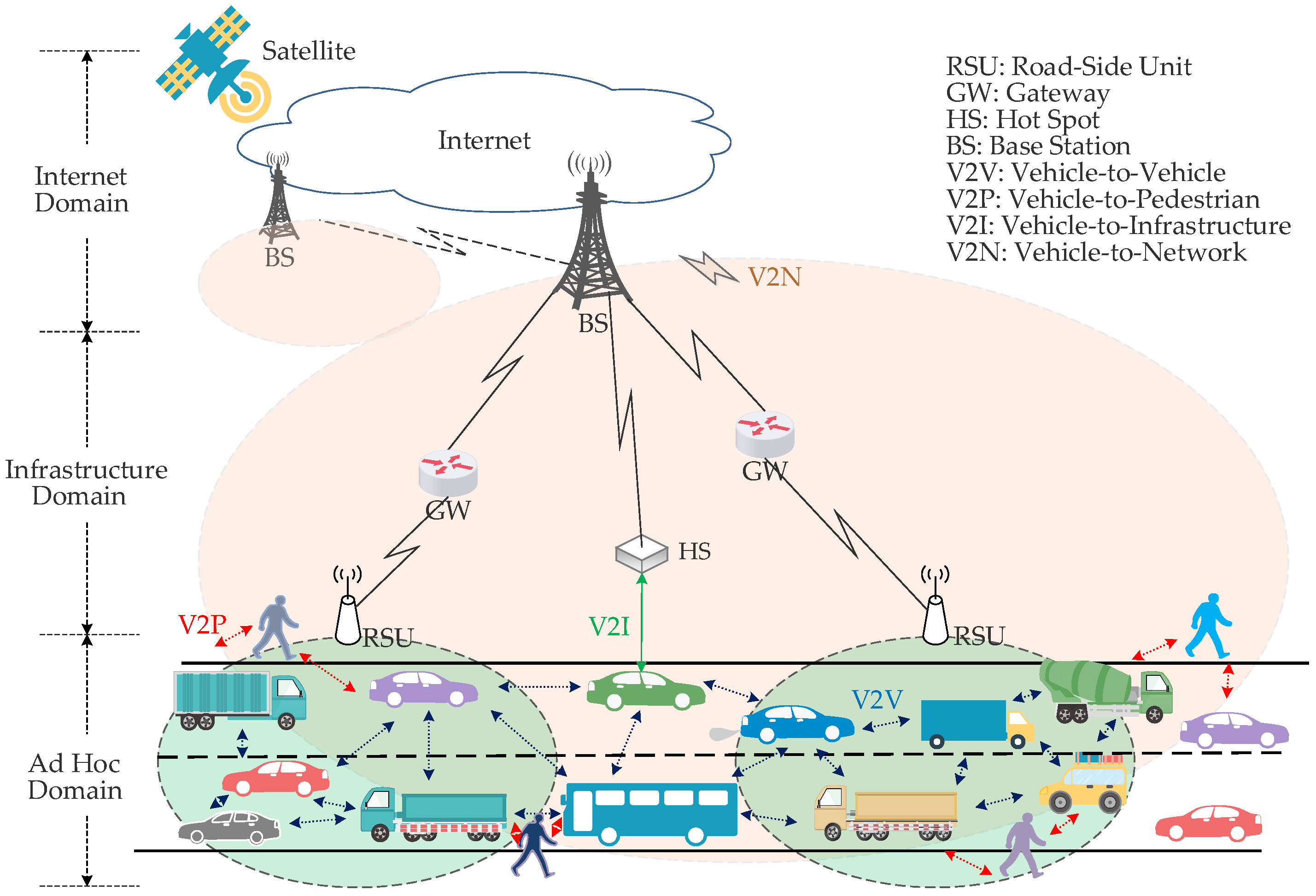
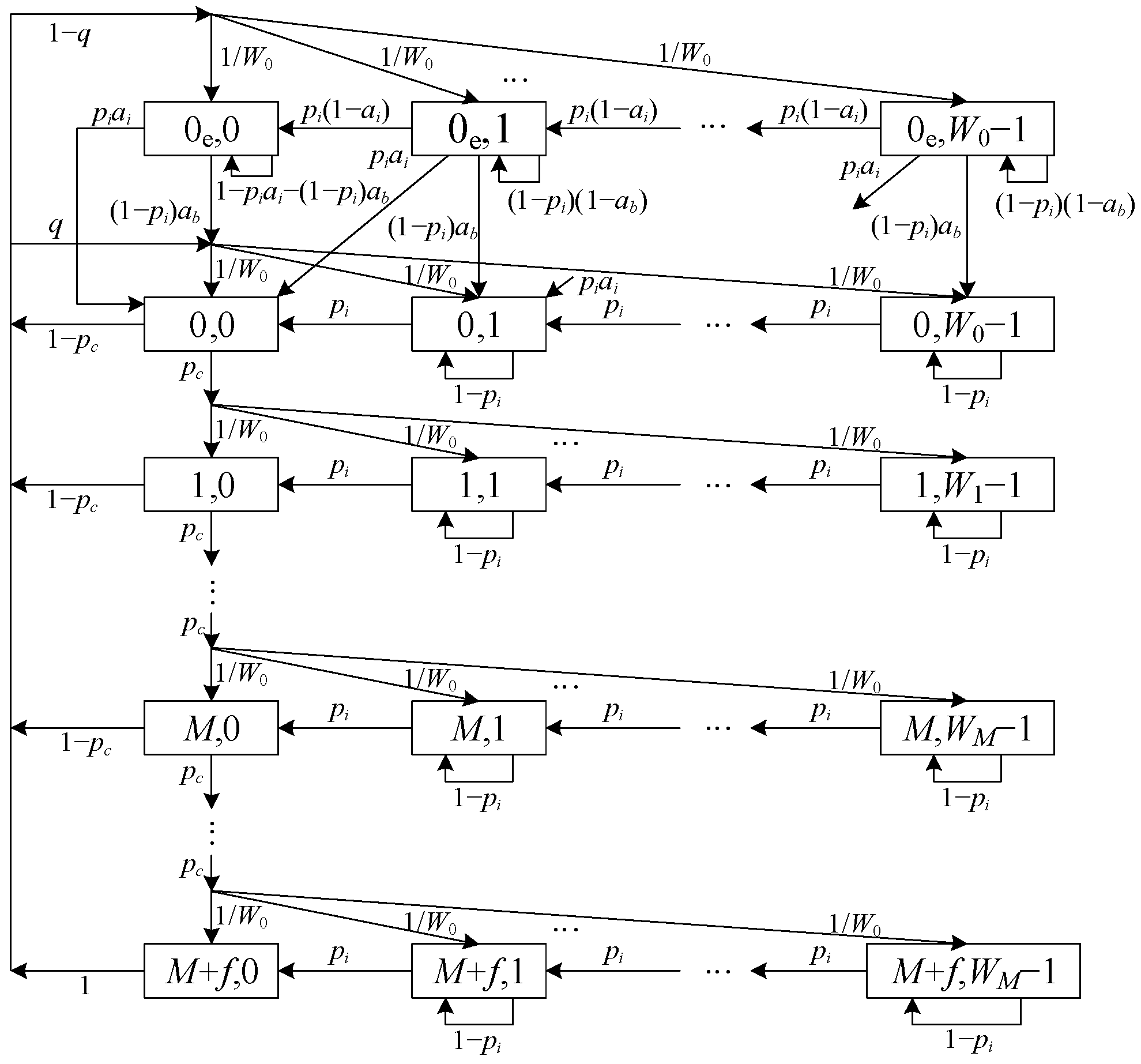

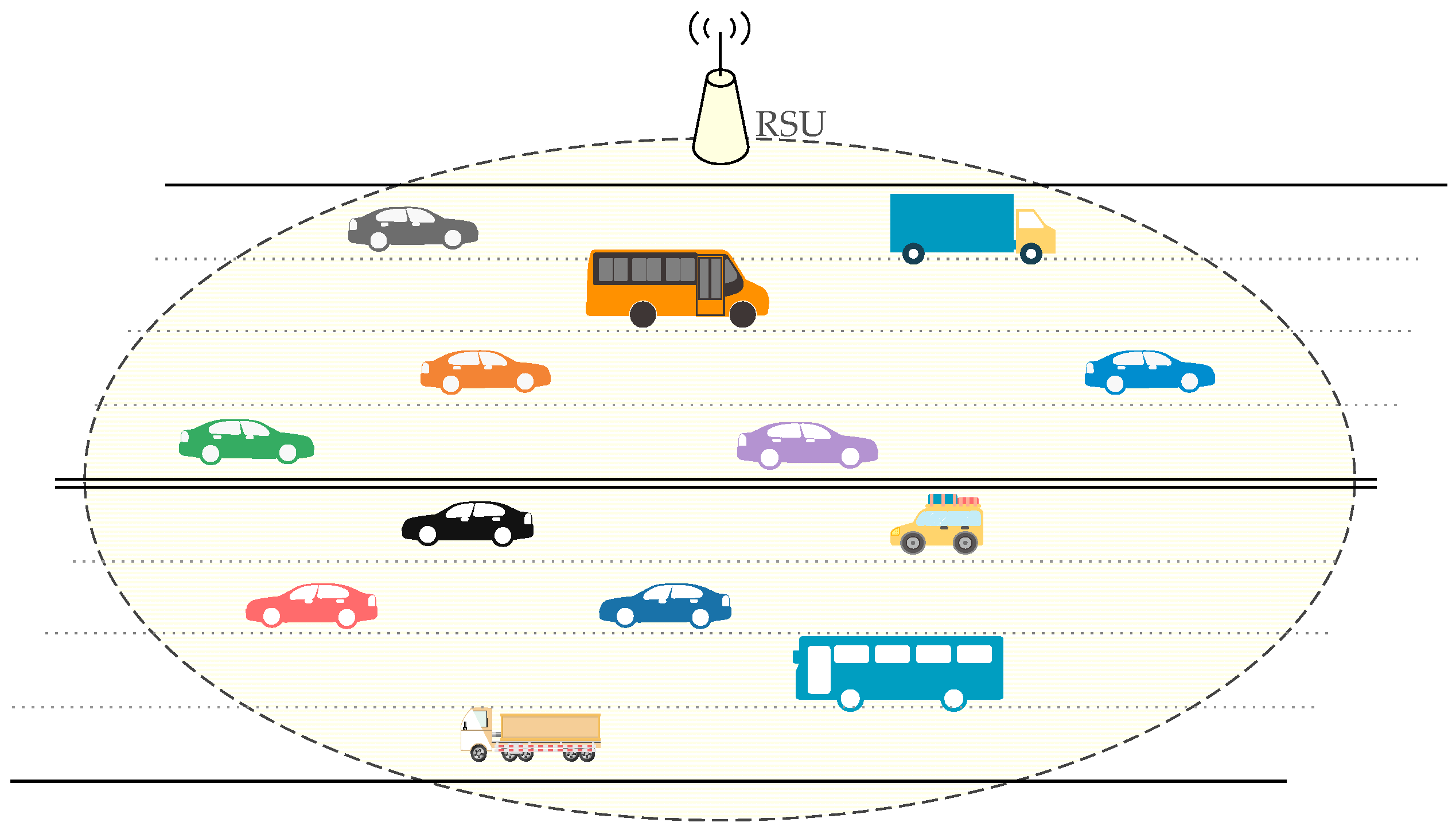
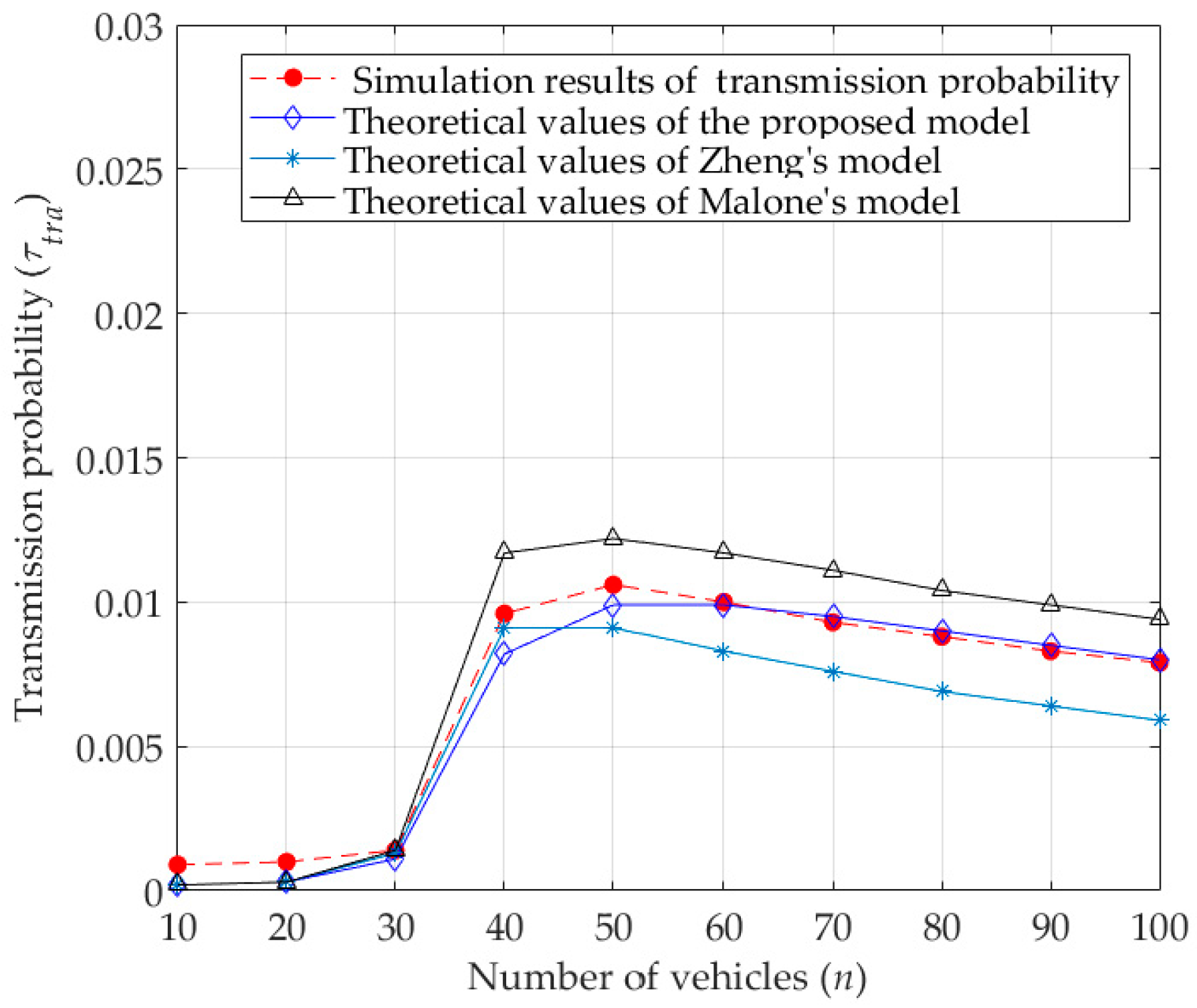
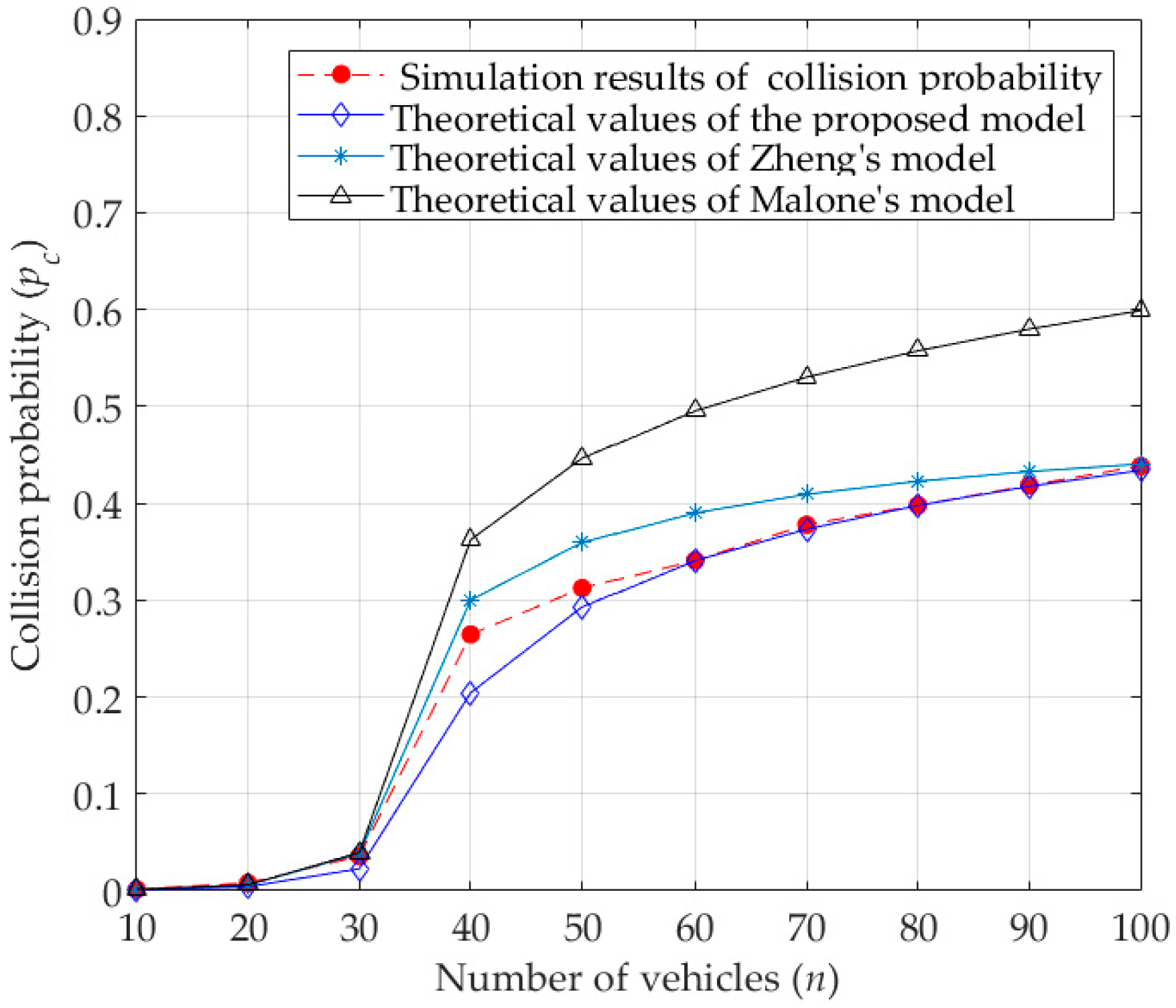

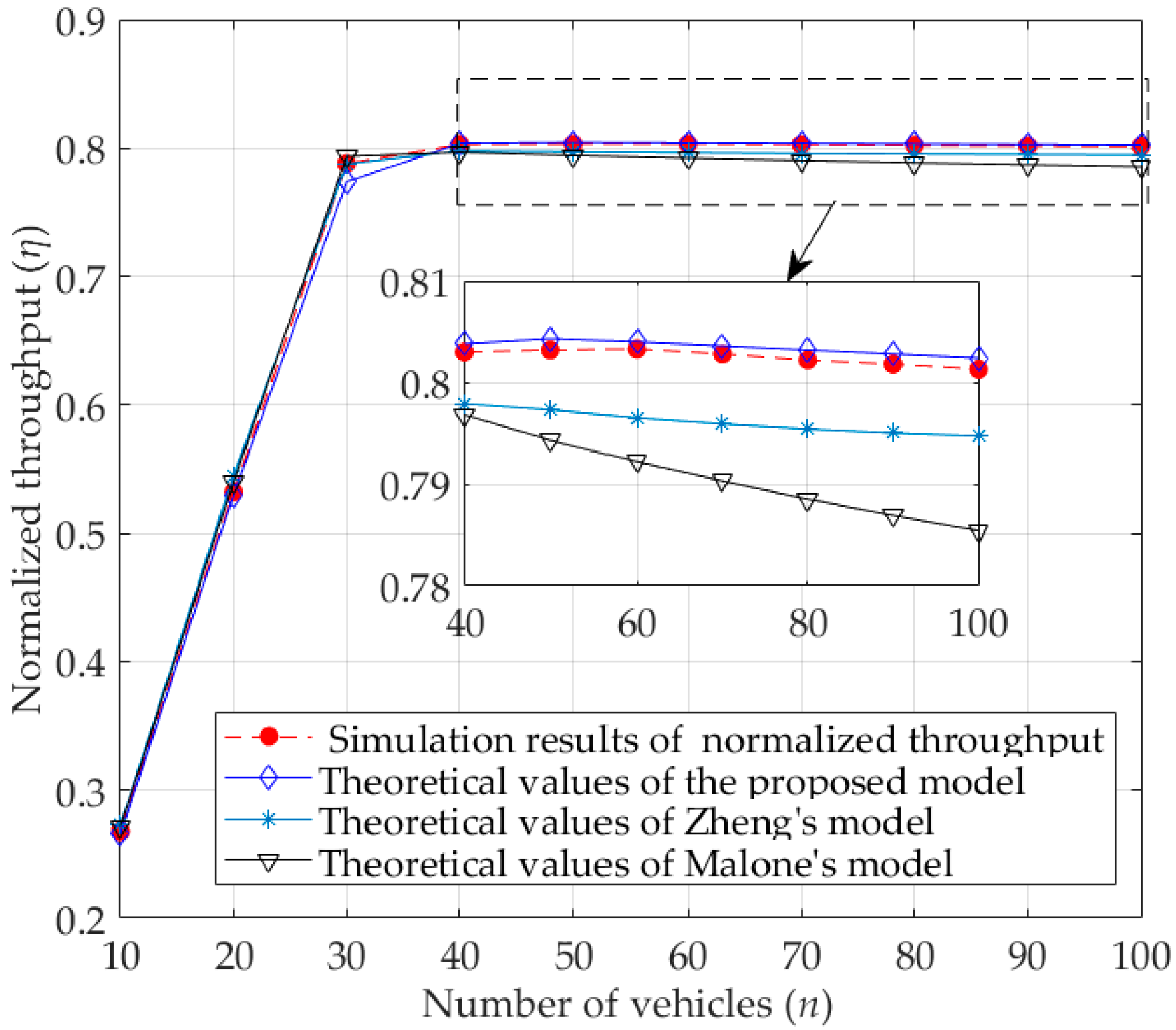
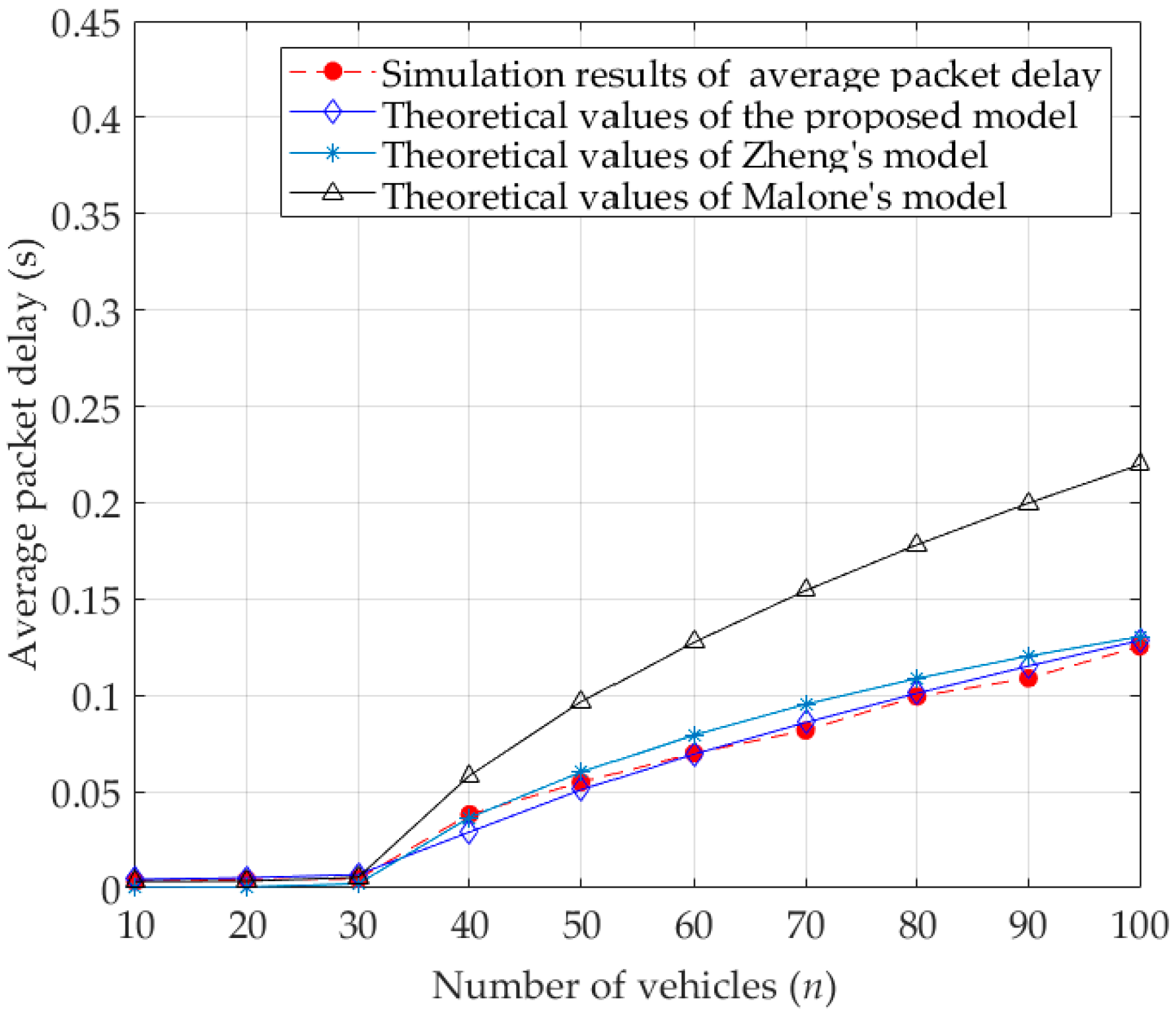

| Abbreviation | Definition |
|---|---|
| 2-D | Two-dimensional |
| 3-D | Three-dimensional |
| AC | Access category |
| ACK | Acknowledgement |
| BEB | Binary exponential backoff |
| BER | Bit error ratio |
| BS | Base station |
| CSMA/CA | Carrier sense multiple access with collision avoidance |
| DCF | Distributed coordination function |
| DIFS | Distributed inter frame space |
| EDCA | Enhanced distributed channel access |
| EDCAF | Enhanced distributed channel access function |
| FIFO | Fist-in-first-out |
| GW | Gateway |
| HS | Hot spot |
| IoV | Internet of vehicles |
| MAC | Medium access control |
| NAV | Network allocation vector |
| PHY | Physical |
| RSU | Road-side unit |
| RTS/CTS | Request-to-send/clear-to-send |
| SIFS | Short inter-frame space |
| TXOP | Transmission opportunity |
| VANET | Vehicular ad hoc network |
| V2I | Vehicle-to-infrastructure |
| V2N | Vehicle-to-network |
| V2P | Vehicle-to-pedestrian |
| V2V | Vehicle-to-vehicle |
| Notion | Definition |
|---|---|
| Contention window of backoff stage j | |
| Minimum contention window | |
| Maximum contention window | |
| Maximum backoff stage | |
| Retransmission times in the maximum backoff stage | |
| Duration of a backoff slot | |
| Packet arrival rate of upper layer | |
| Effective packet arrival rate | |
| The probability that the cache queue is not empty | |
| The probability of packet arrival when the channel is busy | |
| The probability of a packet arriving when the channel is idle | |
| The probability that the channel is idle during one backoff slot | |
| Transmission probability under unsaturated condition | |
| Transmission probability under saturated condition | |
| The probability that at least one vehicle transmits | |
| The probability of successful transmission under unsaturated condition | |
| The probability of collided transmission under unsaturated condition | |
| The probability of collided transmission under saturated condition | |
| The probability of successful transmission when at least one vehicle transmits | |
| Capture threshold | |
| The parameter of Nakagami fading | |
| The probability of capture effect | |
| Duration of the virtual slot under unsaturated condition | |
| Duration of busy channel | |
| Average time for successful transmission | |
| Average time for collided transmission | |
| Effective service rate of packets | |
| Service rate of successfully transmitted packets | |
| Overflow rate of packets | |
| Service intensity | |
| Steady-state probability when the queue length is k | |
| The length of payload | |
| The time required to successfully transmit the payload | |
| The data rate | |
| Basic transmission rate | |
| Overflow probability of cache queue | |
| Queue delay | |
| Delay of MAC layer | |
| Average number of packets in the cache queue | |
| Average packet delay | |
| Number of vehicles |
| Parameters | Setting |
|---|---|
| 1024 bytes | |
| 224 bits | |
| 192 bits | |
| ACK | 304 bits |
| RTS | 352 bits |
| CTS | 304 bits |
| 32 | |
| 58 | |
| 13 | |
| 2 | |
| 3 Mbps | |
| 1.5 | |
| 2 | |
| 32 | |
| 1024 | |
| 5 | |
| 2 | |
| 10 pkts/s | |
| Simulation time | 200 s |
Disclaimer/Publisher’s Note: The statements, opinions and data contained in all publications are solely those of the individual author(s) and contributor(s) and not of MDPI and/or the editor(s). MDPI and/or the editor(s) disclaim responsibility for any injury to people or property resulting from any ideas, methods, instructions or products referred to in the content. |
© 2023 by the authors. Licensee MDPI, Basel, Switzerland. This article is an open access article distributed under the terms and conditions of the Creative Commons Attribution (CC BY) license (https://creativecommons.org/licenses/by/4.0/).
Share and Cite
Wang, Y.; Shi, J.; Fang, Z.; Chen, L. A Novel Analytical Model for the IEEE 802.11p/bd Medium Access Control, with Consideration of the Capture Effect in the Internet of Vehicles. Sensors 2023, 23, 9589. https://doi.org/10.3390/s23239589
Wang Y, Shi J, Fang Z, Chen L. A Novel Analytical Model for the IEEE 802.11p/bd Medium Access Control, with Consideration of the Capture Effect in the Internet of Vehicles. Sensors. 2023; 23(23):9589. https://doi.org/10.3390/s23239589
Chicago/Turabian StyleWang, Yang, Jianghong Shi, Zhiyuan Fang, and Lingyu Chen. 2023. "A Novel Analytical Model for the IEEE 802.11p/bd Medium Access Control, with Consideration of the Capture Effect in the Internet of Vehicles" Sensors 23, no. 23: 9589. https://doi.org/10.3390/s23239589
APA StyleWang, Y., Shi, J., Fang, Z., & Chen, L. (2023). A Novel Analytical Model for the IEEE 802.11p/bd Medium Access Control, with Consideration of the Capture Effect in the Internet of Vehicles. Sensors, 23(23), 9589. https://doi.org/10.3390/s23239589






